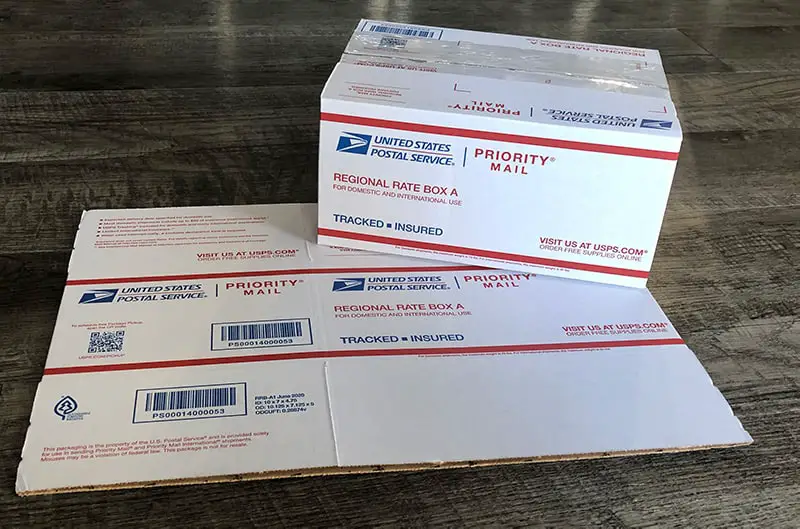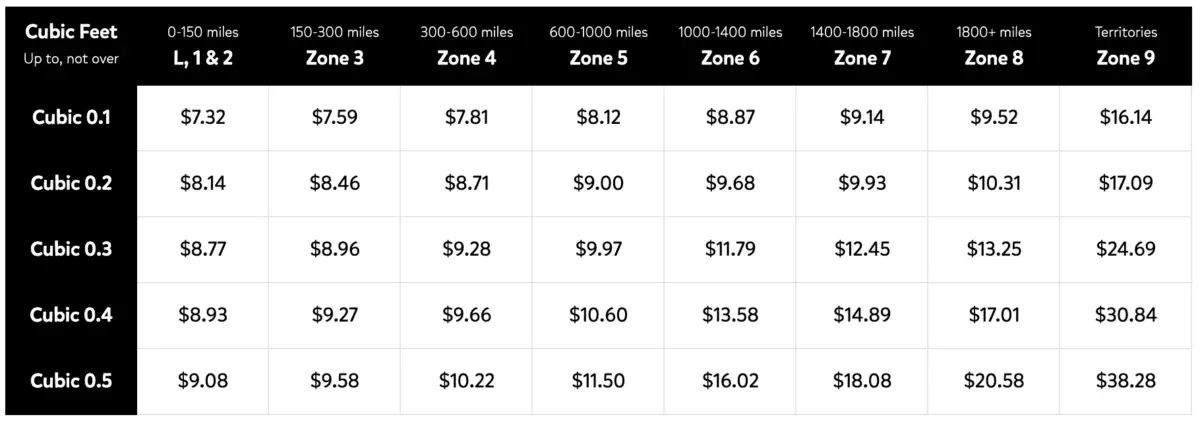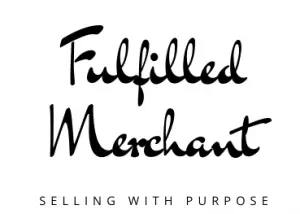
Understanding how to ship a package and how to do so the cheapest way possible can save you a lot of money. This is especially the case if you sell online. There are many shipping services and options out there. USPS Priority mail regional boxes are often the most overlooked shipping options but does it provide value for your shipping needs?
We will go over what you need to know so that you can consider them for your next shipment. You will be able to determine whether using a priority mail region box is the right shipping option for you.
How Do You Use Priority Mail Regional Boxes
When it comes to shipping a package, there are usually three main factors that determine the shipping cost: weight, dimension, and distance. USPS regional rate boxes have a predetermined weight limit and a fixed dimension. They come in two sizes: regional box a and regional box b.
| Regional Box A | Regional Box B | |
| Weight Limit | 15 pounds | 20 pounds |
| Dimensions Top Loading | 10″ x 7″ x 4-3/4″ | 12″ x 10-1/4″ x 5″ |
| Dimensions Side Loading | 12-13/16″ x 10-15/16″ x 2-3/8 | 15-7/8″ x 14-3/8″ x 2-7/8″ |
The shipping cost of regional rates is determined by the distance traveled. So as long as your item fits inside the regional box of your choice and it is below the weight limit, you can use them. There are 9 zones within the United States and its territories.
Each zone is classified by the distance in miles that your package will be traveling from the origin. The farther the distance from where you are shipping from to your package’s destination, the higher the zone number will be. And the higher the zone number, the more expensive the shipping cost.
When To Use Priority Mail Regional Boxes
To determine if you should use regional boxes, here is a cost guide based on each zone. Each zone is determined by the distance that the package will travel. Note that these are with commercial pricing. It will cost more if you buy postage directly from a USPS counter or USPS Click-N-Ship.
| Distance in miles | Cost To Ship Regional Box A | Cost To Ship Regional Box B | |
| Zone 1 | 1-50 | $7.83 | $8.23 |
| Zone 2 | 51-150 | $7.83 | $8.23 |
| Zone 3 | 151-300 | $8.04 | $8.64 |
| Zone 4 | 301-600 | $8.34 | $9.56 |
| Zone 5 | 601-1000 | $9.01 | $12.36 |
| Zone 6 | 1001-1400 | $10.89 | $17.50 |
| Zone 7 | 1401-1800 | $11.63 | $20.10 |
| Zone 8 | 1801 or greater | $12.64 | $22.90 |
| Zone 9 | US territories | $23.37 | $42.98 |
When To Use Regional A Box
As you can see from the cost table above, USPS regional rate box A can be a good option if you are shipping to a destination in the smaller zones. That limits you to mostly ship within your state or a neighboring state. As your zone and distance increase, there are other shipping options that will give you a better rate with more room for your contents.
When To Use Regional B Box
Like the regional box a, it may only make sense to ship if your recipient is within closer zones. However, regional box b rarely makes sense to use because the dimensions are not practical for the price that it costs to ship. You may be better off using a flat rate box for more space and a higher weight limit for farther distances.
Why You Should Not Use Priority Mail Regional Boxes
USPS regional boxes are not generally the cheapest shipping options. There are many other shipping options to consider before you choose this shipping option. One of the best alternatives to shipping with priority mail regional box rates is using a cubic rate.
USPS cubic pricing allows businesses that ship more than 50,000 a year to get a deep discount on shipping. Instead of using weight, cubic rate uses the box or bag dimensions and distance to determine the shipping cost. Even as an individual or small business owner, you can have access to cubic pricing by using a shipping software.
Shipping software is free to use and buying postage will give you commercial pricing, instead of paying retail. These shipping software companies have a negotiated rate with USPS because they do ship more than 50,000 packages a year. And depending on which shipping software you use, they also have a discount on other carriers.
USPS Priority Mail: Regional Box Rates Versus Cubic Rate
To see which pricing is better, we will compare cubic rate against regional box a. Since weight is not considered for cubic pricing, we will use the same outer dimensions of Priority regional box A. We will use the top-loading dimensions of 10″ x 7″ x 4-3/4″. You can enter these dimensions into a calculator here.

The calculation will give us 0.193 cubic volume. As shown by this cubic rate table from Pirate ship, we will round up to 0.2 cubic feet. Using the cubic volume guide of 0.2 and the 9 zones, we see this table below.
| Distance in miles | Cost To Ship Regional Box A | Cost To Ship Cubic Rate | |
| Zone 1 | 1-50 | $7.83 | $8.14 |
| Zone 2 | 51-150 | $7.83 | $8.14 |
| Zone 3 | 151-300 | $8.04 | $8.46 |
| Zone 4 | 301-600 | $8.34 | $8.71 |
| Zone 5 | 601-1000 | $9.01 | $9.00 |
| Zone 6 | 1001-1400 | $10.89 | $9.68 |
| Zone 7 | 1401-1800 | $11.63 | $9.93 |
| Zone 8 | 1801 or greater | $12.64 | $10.31 |
| Zone 9 | US territories | $23.37 | $17.09 |
It is clear that given the same dimensions, it is cheaper to use cubic rate instead of a priority mail regional box for distances greater than 600 miles. However, keep in mind that we used the exact dimensions of the regional box a. If you are able to get your box smaller to a cubic volume of 0.1, you will be able to ship for much cheaper,
USPS Priority Mail Regional Rate Box A Versus Flat Rate
How do priority mail regional rate boxes compare with flat rate boxes? Regional box a is larger than a small flat rate and smaller than a medium flat rate. So we will compare with the larger of the two. Here is a table below of their dimensions and weight limits.
| Priority Mail Regional Box A | Priority Mail Flat Rate Medium | |
| Weight Limit | 15 pounds | 70 pounds |
| Dimensions Top Loading | 10″ x 7″ x 4-3/4″ | 11 1⁄4″ x 8 3⁄4″ x 6″ |
| Dimensions Side Loading | 12-13/16″ x 10-15/16″ x 2-3/8 | 14″ x 12″ x 3 1⁄2″ |
So what is the difference in price to ship? All priority mail flat rate boxes and envelopes will have a flat price regardless of distance.
| Distance in miles | Cost To Ship Regional Box A | Cost To Ship Flat Rate Medium | |
| Zone 1 | 1-50 | $7.83 | $13.75 |
| Zone 2 | 51-150 | $7.83 | $13.75 |
| Zone 3 | 151-300 | $8.04 | $13.75 |
| Zone 4 | 301-600 | $8.34 | $13.75 |
| Zone 5 | 601-1000 | $9.01 | $13.75 |
| Zone 6 | 1001-1400 | $10.89 | $13.75 |
| Zone 7 | 1401-1800 | $11.63 | $13.75 |
| Zone 8 | 1801 or greater | $12.64 | $13.75 |
| Zone 9 | US territories | $23.37 | $13.75 |
Priority mail flat rate boxes will make sense or shipping heavy packages across the country or US territories. Always compare all the rates to see your best option.
Does Priority Mail Regional Box A Offer Good Value?

There are a few things to know about using a priority regional box. You cannot use your own box to get the regional box rates, you must use the exact box that USPS provides. You can find them at your local post office or order them online at usps.com.
Regional box A will not make sense for any long distances. However, they can offer good value for packages that do not qualify for First Class or for heavier packages in zones 1-4. You will want to use cubic rate for anything farther or consider flat rate envelopes and boxes.
There are also many other shipping options beyond using a USPS regional box, flat rate box, or envelopes. USPS has many box size options for regular priority mail. Your local post office may not have them all. However, you can order them for free shipping to your home with your USPS account.
How To Save Money On Shipping
When it comes to saving money shipping, your best resource will be to use shipping software. Make sure you also take advantage of the free shipping resources available to you here.
As with shipping any package, make sure you have a shipping scale and a measuring tape. These will ensure that you are entering the weight and dimensions correctly without guessing. They will also save you money and headaches in the long run.
Guessing your package weight wrong could mean that the post office will require your recipient to pay the difference to receive the item. Or the package may be returned to you, the sender. If you are a small business, this could mean unhappy customers.
If you have lost or damaged mail using a regional rate box, you can start a USPS insurance claim here. All priority mail, including regional boxes, comes with $50 or $100 of built-in insurance depending on where you buy your postage.
